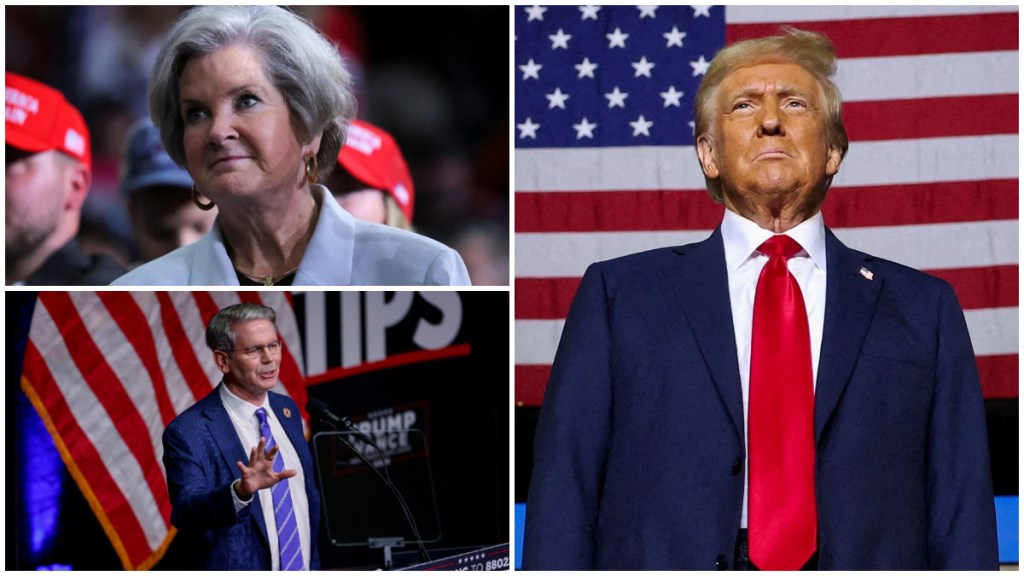Donald Trump’s Cabinet choices are under the spotlight. While some say, it reflects a mixture of historic firsts, a focus on gender and racial diversity, and a generational shift, others claim that some patterns in representation remain consistent with past administrations. Although the diversity factor in Trump’s Cabinet falls short compared to his predecessor, President Joe Biden, but his selections showcase a blend of traditional political experience and new faces, including younger leaders, reported Reuters. From a female White House Chief of Staff to a potential first openly gay Republican Cabinet member – Scott Bessent, Trump’s picks show a bold step forward in some areas.
Susie Wiles, Scott Bessent – Historic Firsts in Trump’s Cabinet
Several of Trump’s Cabinet picks represent milestones in US political history that set new precedents in American government. Among the most notable is Susie Wiles, the Florida political operative who ran Trump’s 2024 campaign and is poised to become the first woman in the history to serve as White House Chief of Staff.
Another significant pick is Marco Rubio, the US Senator from Florida, who if confirmed as Secretary of State, would become the first person of Hispanic descent to hold this prestigious position. Additionally, Scott Bessent, a hedge fund executive, has been nominated for Treasury Secretary, and could become the first openly gay Republican Cabinet member if confirmed.
Trump’s Cabinet also includes Tulsi Gabbard, the former US Representative, who would break barriers as the first Pacific Islander to serve as Director of National Intelligence.
Gender, Racial Representation in Trump’s Cabinet vs Biden, Obama and Bush’s Cabinets
Gender representation in Trump‘s Cabinet shows improvement, with eight women nominated, double the number from his first-term Cabinet. However, this falls short of President Biden’s inaugural Cabinet, which included 11 women, later rising to 13, a historic high.
By comparison, other administrations also made strides in this area, with Barack Obama appointing eight women and George W Bush selecting five. Racial diversity in Trump’s Cabinet, with four people of colour, mirrors the diversity level from his first term but still falls short of the US population’s 40% minority share, according to census data. For context, Biden’s Cabinet included 13 people of color, Obama’s had 10, and Bush’s Cabinet was made up of six.
A Generational Shift
Trump’s Cabinet picks also represent a generational shift, with several younger leaders stepping into significant roles. Elise Stefanik, 40, has been nominated as the next UN Ambassador and could become the youngest person ever to hold that position. Another standout is Karoline Leavitt, 27, who is slated to become the youngest White House Press Secretary in history after working on Trump’s 2024 campaign. This blend of experience and youthful energy highlights the potential for a generational renewal in American politics.
Political Experience and Media Influence
While many of Trump’s Cabinet picks bring political experience from state or federal government, others are outsiders with ties to industries the Cabinet members will regulate. For example, Scott Bessent, Howard Lutnick (Commerce Secretary nominee), and Chris Wright (Energy Secretary nominee) have experience in the private sector. Trump’s selection also reflects a deep connection to the media landscape, with several picks having prominent TV personalities in their backgrounds. Dr. Mehmet Oz, known for his medical talk show, is nominated for Centers for Medicare and Medicaid Services. In addition, Pete Hegseth, Sean Duffy, and Dr. Janette Nesheiwat, all former Fox News employees, are tapped for key roles in Defense, Transportation, and as U.S. Surgeon General, respectively.
Trump’s Cabinet picks reflect both continuity and change, blending new faces with traditional political figures and bringing historic milestones for women, people of color, and younger generations. While the diversity level may fall short of some expectations, these selections offer insight into the president-elect’s priorities as he shapes his administration.
(With Reuters Inputs)

